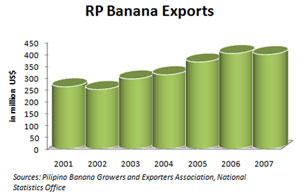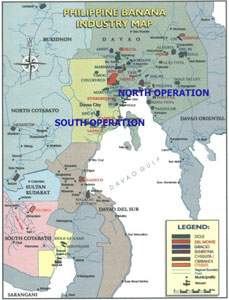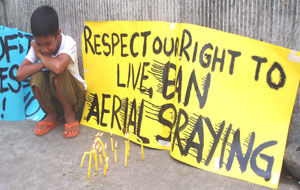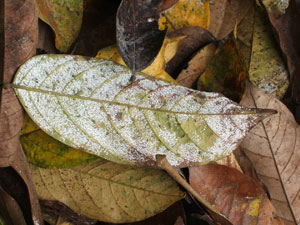Filtered by: Topstories
News
Davao City govt, farmers push ban on aerial pesticide spraying
By YASMIN D. ARQUIZA, VERA Files
 (First of two parts) DAVAO CITY, Philippines — Once a week, the drone of airplanes shatters the early morning calm in Calinan, a cluster of small farmlands in the hilly terrain around Mount Apo. It is the signal for farmers to rush indoors or take cover and stop feeding livestock, for women to pull down clothes hanging out to dry, and for everyone to stay indoors, windows shuttered. The small fixed-wing planes, known as crop dusters, are owned by the huge banana plantations nearby, spraying fungicide—a kind of pesticide that destroys fungus—on the banana plants. Residents say anyone caught outdoors during an aerial spray is likely to experience skin itching, eye irritation and nausea. Water exposed to fungicide turns milky white, and vegetables like malunggay curl up or retain a sticky residue.
(First of two parts) DAVAO CITY, Philippines — Once a week, the drone of airplanes shatters the early morning calm in Calinan, a cluster of small farmlands in the hilly terrain around Mount Apo. It is the signal for farmers to rush indoors or take cover and stop feeding livestock, for women to pull down clothes hanging out to dry, and for everyone to stay indoors, windows shuttered. The small fixed-wing planes, known as crop dusters, are owned by the huge banana plantations nearby, spraying fungicide—a kind of pesticide that destroys fungus—on the banana plants. Residents say anyone caught outdoors during an aerial spray is likely to experience skin itching, eye irritation and nausea. Water exposed to fungicide turns milky white, and vegetables like malunggay curl up or retain a sticky residue.  Because of their rapid expansion, Davao’s big banana plantations are encroaching into the city’s built-up areas and farmlands like Calinan, where small farmers grow crops and fruits such as durian and lanzones that are sold in Davao City markets. Communities around these plantations have been complaining of health problems every time toxic pesticides would drift their way. Convinced of its ill effects on health and environment, the city government of Davao passed an ordinance in February last year banning the aerial spraying of pesticides. City officials and small farmers have since been locked in a legal battle with the banana companies over the ban. When powerful banana growers questioned the constitutionality of the ordinance, the lower court upheld the ban, as did the Office of the Solicitor General. It was only in the Court of Appeals where banana companies scored a victory: The CA issued an injunction to stop the ban, allowing them to continue aerial spraying.
Because of their rapid expansion, Davao’s big banana plantations are encroaching into the city’s built-up areas and farmlands like Calinan, where small farmers grow crops and fruits such as durian and lanzones that are sold in Davao City markets. Communities around these plantations have been complaining of health problems every time toxic pesticides would drift their way. Convinced of its ill effects on health and environment, the city government of Davao passed an ordinance in February last year banning the aerial spraying of pesticides. City officials and small farmers have since been locked in a legal battle with the banana companies over the ban. When powerful banana growers questioned the constitutionality of the ordinance, the lower court upheld the ban, as did the Office of the Solicitor General. It was only in the Court of Appeals where banana companies scored a victory: The CA issued an injunction to stop the ban, allowing them to continue aerial spraying.  Last July, the Davao City government, in alliance with farmers, asked the Supreme Court to break the impasse in what is now considered a landmark case that will test the power of the local government to protect public welfare. Aerial spraying is done on 1,800 hectares, about one-third the total area of banana plantations in Davao City, said a fact-finding report headed by City Planning and Development coordinator Mario Luis Jacinto. Pilots guided by Global Positioning System devices spray 30 liters of solution per hectare using automated nozzles. Although the Philippines has no specific law on aerial spraying, government regulations require pilots to observe buffer zones “20 to 30 meters away" from plantations, according to regional officer Estrella Laquinta of the Fertilizer and Pesticide Authority. The rule is meant to spare humans, animals and plants from the ill effects of the spraying. But it is a rule only on paper. Rosita Bacalso, whose farm is just three meters away from the Cavendish banana plantation of Davao Fruits Corp. (DFC), said she saw white insects swarming toward her coconut trees from the corporate farm when aerial spraying began in 2004. The coconut fronds turned black and began falling off, while the young fruits failed to mature fully. As a result, her usual income of P12,000 from coconuts fell to P3,000 every quarter. On one occasion, Bacalso recalled, she looked in horror at a glass of water from the tap after heavy rains washed off pesticide residues from the gutter into their water tank. “Murag gatas. Mao ni ang among ginainom (It was milky. Is this what we’ve been drinking)?" she wondered. Since then, the family has been fetching water from the community tank 200 meters away. Another farmer, Virginia Cata-ag, said members of her family experienced eye irritation, nausea and skin diseases after getting directly hit by pesticide spray. Her house in barangay Sirib is surrounded by a DFC banana plantation, the nearest border just 10 meters away, and the company does not notify them when aerial spraying would be done. In barangay Dacudao, longtime resident Cecilia Moran said her family had to sell their cows that started getting sick from grazing on pasture land hit by pesticide spray. Leafy vegetables such as malunggay and camote tops curled up or had sticky residue that could not be washed off, forcing them to buy from the market what had once been a daily supply of fresh produce from their own farm. Just a ‘perceived’ problem
Last July, the Davao City government, in alliance with farmers, asked the Supreme Court to break the impasse in what is now considered a landmark case that will test the power of the local government to protect public welfare. Aerial spraying is done on 1,800 hectares, about one-third the total area of banana plantations in Davao City, said a fact-finding report headed by City Planning and Development coordinator Mario Luis Jacinto. Pilots guided by Global Positioning System devices spray 30 liters of solution per hectare using automated nozzles. Although the Philippines has no specific law on aerial spraying, government regulations require pilots to observe buffer zones “20 to 30 meters away" from plantations, according to regional officer Estrella Laquinta of the Fertilizer and Pesticide Authority. The rule is meant to spare humans, animals and plants from the ill effects of the spraying. But it is a rule only on paper. Rosita Bacalso, whose farm is just three meters away from the Cavendish banana plantation of Davao Fruits Corp. (DFC), said she saw white insects swarming toward her coconut trees from the corporate farm when aerial spraying began in 2004. The coconut fronds turned black and began falling off, while the young fruits failed to mature fully. As a result, her usual income of P12,000 from coconuts fell to P3,000 every quarter. On one occasion, Bacalso recalled, she looked in horror at a glass of water from the tap after heavy rains washed off pesticide residues from the gutter into their water tank. “Murag gatas. Mao ni ang among ginainom (It was milky. Is this what we’ve been drinking)?" she wondered. Since then, the family has been fetching water from the community tank 200 meters away. Another farmer, Virginia Cata-ag, said members of her family experienced eye irritation, nausea and skin diseases after getting directly hit by pesticide spray. Her house in barangay Sirib is surrounded by a DFC banana plantation, the nearest border just 10 meters away, and the company does not notify them when aerial spraying would be done. In barangay Dacudao, longtime resident Cecilia Moran said her family had to sell their cows that started getting sick from grazing on pasture land hit by pesticide spray. Leafy vegetables such as malunggay and camote tops curled up or had sticky residue that could not be washed off, forcing them to buy from the market what had once been a daily supply of fresh produce from their own farm. Just a ‘perceived’ problem  The Pilipino Banana Growers and Exporters Association (PBGEA), together with DFC and Lapanday Agricultural and Development Corp. (LADC), has dismissed the complaints against aerial spraying of fungicide as “a perceived (but nonexisting) problem." In a petition with the Regional Trial Court to declare the city ordinance invalid, the banana companies claimed that “fungicides are comparable to safe household items such as Nizoral anti-dandruff shampoo or anti-fungal preparations such as Trosyd." The firms said aerial spraying of fungicide is necessary to control the Black Sigatoka disease, which mainly attacks leaves. If the infection spreads to fruits, the bananas can “suffer from premature ripening, rendering them useless for export." In the same petition, however, the banana companies admitted that a simple way to eradicate the Sigatoka disease without resorting to aerial spraying of pesticide “is to cut off the leaves and prevent the spread of the disease to other nearby banana plants." Reacting to the city government’s report that other banana plantations use truck-mounted boom spray to manually apply 80 to 200 liters of fungicide solution per hectare, the companies said this method only covers up to 60 hectares per day, compared to aerial spraying that covers 250 hectares in three hours. “Aerial spraying is the method of choice considering that it is the safest, most effective, and most accurate method of applying the water cocktail containing the fungicide," the banana firms said in their petition. The banana companies also disputed testimonies of residents that they do not issue warnings. They said an alarm is sounded 15 minutes before the planes start spraying fungicide, and notices about spraying schedules are placed in strategic areas. They also said the first three loads are sprayed near the boundaries at daybreak to avoid foot traffic, before the planes start spraying toward the interior of the plantation. In Calinan, people usually wake up and go to their farms at dawn.
The Pilipino Banana Growers and Exporters Association (PBGEA), together with DFC and Lapanday Agricultural and Development Corp. (LADC), has dismissed the complaints against aerial spraying of fungicide as “a perceived (but nonexisting) problem." In a petition with the Regional Trial Court to declare the city ordinance invalid, the banana companies claimed that “fungicides are comparable to safe household items such as Nizoral anti-dandruff shampoo or anti-fungal preparations such as Trosyd." The firms said aerial spraying of fungicide is necessary to control the Black Sigatoka disease, which mainly attacks leaves. If the infection spreads to fruits, the bananas can “suffer from premature ripening, rendering them useless for export." In the same petition, however, the banana companies admitted that a simple way to eradicate the Sigatoka disease without resorting to aerial spraying of pesticide “is to cut off the leaves and prevent the spread of the disease to other nearby banana plants." Reacting to the city government’s report that other banana plantations use truck-mounted boom spray to manually apply 80 to 200 liters of fungicide solution per hectare, the companies said this method only covers up to 60 hectares per day, compared to aerial spraying that covers 250 hectares in three hours. “Aerial spraying is the method of choice considering that it is the safest, most effective, and most accurate method of applying the water cocktail containing the fungicide," the banana firms said in their petition. The banana companies also disputed testimonies of residents that they do not issue warnings. They said an alarm is sounded 15 minutes before the planes start spraying fungicide, and notices about spraying schedules are placed in strategic areas. They also said the first three loads are sprayed near the boundaries at daybreak to avoid foot traffic, before the planes start spraying toward the interior of the plantation. In Calinan, people usually wake up and go to their farms at dawn.  In an affidavit supporting the banana firms’ petition, plant pathologist Anacleto Pedrosa of the AMS Group of Companies, which includes DFC, asserted that fungicide spray has “no adverse effects" on the skin or respiratory system. “Exposure must be by ingestion. An adult person has to directly ingest 425 milliliters of fungicide (which is more than a bottle of beer) to cause some adverse effect," he said. Pedrosa also downplayed the health risks reported by anti-aerial spraying advocates, claiming that “a person can eat one million apples (directly treated with Mancozeb) a day and still show no adverse effect from the ingestion." Mancozeb is the active ingredient in Dithane 600, a fungicide sprayed in banana plantations, with up to 1.5 liters used for every 30-liter solution, according to Pedrosa. No safe dose In pushing for the ordinance, the joint committees on environment, agriculture and health of the city council rejected the banana companies’ arguments. Instead, they put more weight on the statements of Lynn Panganiban, head of the National Poison Control and Management Center at the University of the Philippines. “There is no such thing as a safe dose when it comes to pesticides," Panganiban said. “Pesticide vapor is the best predator of the child." Anti-aerial spraying advocates often show a photograph of children walking to school while a crop duster flies over a nearby banana plantation in a Davao City suburb. “The theory now of cancer development is a one-cell-hit theory, meaning one molecule in our organ could be hit and this can already produce clonal transformation which will eventually develop into cancer," Panganiban added. At a forum in UP Diliman last July, Panganiban said various studies have linked Mancozeb to health risks such as skin diseases, thyroid gland disorders and cancer.
In an affidavit supporting the banana firms’ petition, plant pathologist Anacleto Pedrosa of the AMS Group of Companies, which includes DFC, asserted that fungicide spray has “no adverse effects" on the skin or respiratory system. “Exposure must be by ingestion. An adult person has to directly ingest 425 milliliters of fungicide (which is more than a bottle of beer) to cause some adverse effect," he said. Pedrosa also downplayed the health risks reported by anti-aerial spraying advocates, claiming that “a person can eat one million apples (directly treated with Mancozeb) a day and still show no adverse effect from the ingestion." Mancozeb is the active ingredient in Dithane 600, a fungicide sprayed in banana plantations, with up to 1.5 liters used for every 30-liter solution, according to Pedrosa. No safe dose In pushing for the ordinance, the joint committees on environment, agriculture and health of the city council rejected the banana companies’ arguments. Instead, they put more weight on the statements of Lynn Panganiban, head of the National Poison Control and Management Center at the University of the Philippines. “There is no such thing as a safe dose when it comes to pesticides," Panganiban said. “Pesticide vapor is the best predator of the child." Anti-aerial spraying advocates often show a photograph of children walking to school while a crop duster flies over a nearby banana plantation in a Davao City suburb. “The theory now of cancer development is a one-cell-hit theory, meaning one molecule in our organ could be hit and this can already produce clonal transformation which will eventually develop into cancer," Panganiban added. At a forum in UP Diliman last July, Panganiban said various studies have linked Mancozeb to health risks such as skin diseases, thyroid gland disorders and cancer.  Saligan, a legal assistance group helping the farmers in their complaints against the banana companies, showed a specimen label of the fungicide Dithane in court that clearly stated it “may cause irritation to nose, throat, eyes and skin." The label also contains the advisory, “Do not breathe dust or spray mist." Several health studies in recent years have shown abnormally high rates of cancer, anemia and skin ailments among residents living beside banana plantations. In a 2006 study, the Kalusugan Alang sa Bayan health group documented nine patients who had died of cancer in a plantation site in Davao City. Seven of them had been working for a long time in the plantation, up to 29 years in one case. Felixberto Batuhan, who used to work in a plantation, cleaning canals and harvesting bananas for three years, blames his employer for the loss of his eyesight. He recalls the pesticide spray getting into the workers’ breakfast, as they had to be inside the plantation at 6 a.m. He is now one of the blind masseurs working in Davao City’s malls. Even the city government’s Jacinto report, which has been widely criticized for allegedly favoring the banana companies, validated the complaints of farmers on the impact of aerial spraying on coconut trees, saying the fronds had become susceptible to attacks. “This can happen when the fungus Metarhizium anisopliae, which infects and kills the Rhinoceros beetle, is eliminated or killed by the fungicides that drift to the coconut. Thus, about three to five rows of coconuts adjacent to the banana plantations commonly manifest Rhinoceros beetle-damaged leaves," the report said. The city ordinance banning aerial spraying had started on a milder note with a resolution from city councilor Nenita Orcullo in 2004 seeking to regulate the practice. Orcullo, who lives in a community where aerial spraying is done, changed the proposal to a total ban a year later following widespread clamor from affected residents in various places.
Saligan, a legal assistance group helping the farmers in their complaints against the banana companies, showed a specimen label of the fungicide Dithane in court that clearly stated it “may cause irritation to nose, throat, eyes and skin." The label also contains the advisory, “Do not breathe dust or spray mist." Several health studies in recent years have shown abnormally high rates of cancer, anemia and skin ailments among residents living beside banana plantations. In a 2006 study, the Kalusugan Alang sa Bayan health group documented nine patients who had died of cancer in a plantation site in Davao City. Seven of them had been working for a long time in the plantation, up to 29 years in one case. Felixberto Batuhan, who used to work in a plantation, cleaning canals and harvesting bananas for three years, blames his employer for the loss of his eyesight. He recalls the pesticide spray getting into the workers’ breakfast, as they had to be inside the plantation at 6 a.m. He is now one of the blind masseurs working in Davao City’s malls. Even the city government’s Jacinto report, which has been widely criticized for allegedly favoring the banana companies, validated the complaints of farmers on the impact of aerial spraying on coconut trees, saying the fronds had become susceptible to attacks. “This can happen when the fungus Metarhizium anisopliae, which infects and kills the Rhinoceros beetle, is eliminated or killed by the fungicides that drift to the coconut. Thus, about three to five rows of coconuts adjacent to the banana plantations commonly manifest Rhinoceros beetle-damaged leaves," the report said. The city ordinance banning aerial spraying had started on a milder note with a resolution from city councilor Nenita Orcullo in 2004 seeking to regulate the practice. Orcullo, who lives in a community where aerial spraying is done, changed the proposal to a total ban a year later following widespread clamor from affected residents in various places.  Earth Day in April 2006 saw the legislation’s supporters coming together under the loose alliance Mamamayan Ayaw sa Aerial Spray, which received logistical support from the environmental group Interface Development Interventions. These groups found an influential ally in televangelist Apollo Quiboloy, whose prayer center in Calinan is adjacent to banana plantations. A video made by his television company showing the misty trail of the crop dusters and calling for a stop to the practice has been made into an anti-aerial spraying campaign material on the Internet. Quiboloy was photographed standing beside Davao City Mayor Rodrigo Duterte when the latter signed the ordinance banning aerial spraying in the metropolis. - Vera Files (To be continued) (VERA Files is put out by veteran journalists taking a deeper look into current issues. Vera is Latin for “true.")
Earth Day in April 2006 saw the legislation’s supporters coming together under the loose alliance Mamamayan Ayaw sa Aerial Spray, which received logistical support from the environmental group Interface Development Interventions. These groups found an influential ally in televangelist Apollo Quiboloy, whose prayer center in Calinan is adjacent to banana plantations. A video made by his television company showing the misty trail of the crop dusters and calling for a stop to the practice has been made into an anti-aerial spraying campaign material on the Internet. Quiboloy was photographed standing beside Davao City Mayor Rodrigo Duterte when the latter signed the ordinance banning aerial spraying in the metropolis. - Vera Files (To be continued) (VERA Files is put out by veteran journalists taking a deeper look into current issues. Vera is Latin for “true.") More Videos
Most Popular




